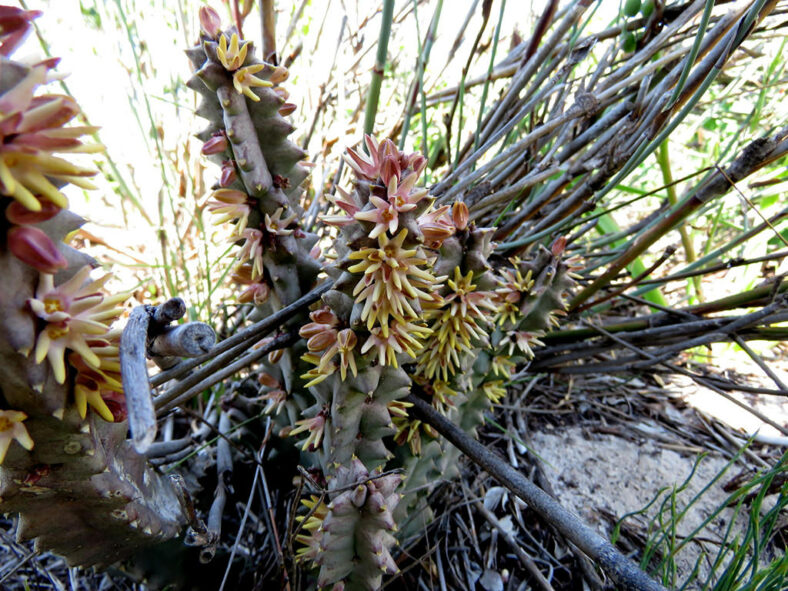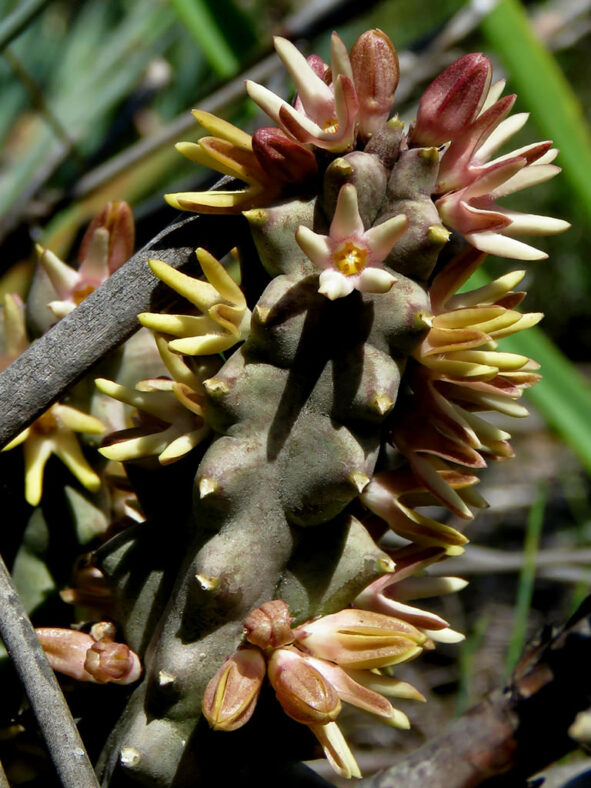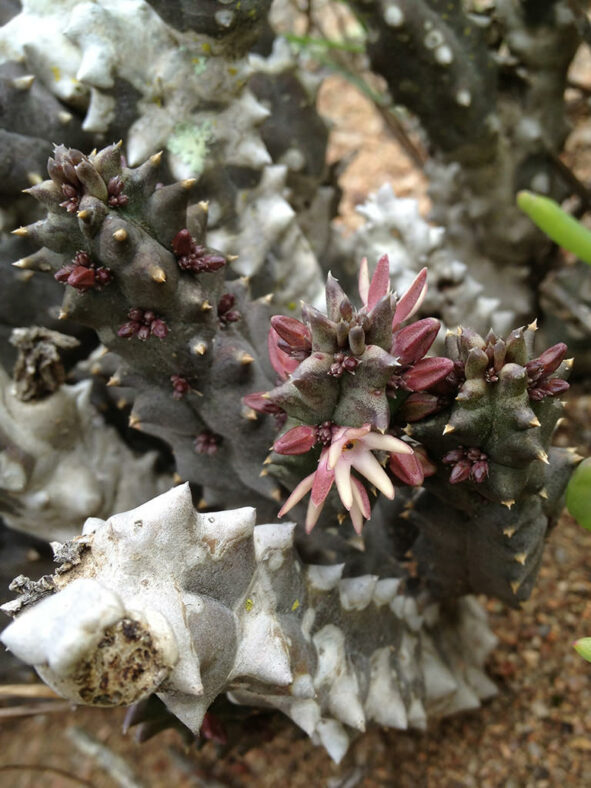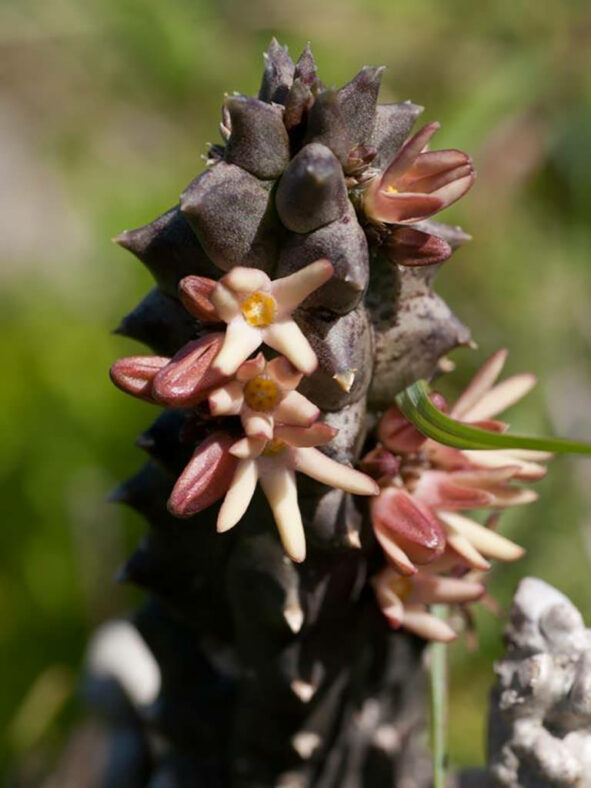Quaqua incarnata is similar to Quaqua aurea, but the flower tube is at least as long as the corona, and the papillae are restricted to the mouth of the tube.
Scientific Name
Quaqua incarnata (L.fil.) Bruyns
Synonym(s)
Boucerosia incarnata, Caralluma incarnata, Ceropegia incarnata, Piaranthus incarnatus, Podanthes incarnata, Quaqua incarnata subsp. incarnata, Stapelia incarnata
Scientific Classification
Family: Apocynaceae
Subfamily: Asclepiadoideae
Tribe: Ceropegieae
Subtribe: Stapeliinae
Genus: Quaqua
Etymology
The specific epithet "incarnata (pronounced in-kar-NAH-tuh) means "flesh-colored" and refers to the color of the flowers.
Origin
The native range of Quaqua incarnata extends from Aus in southern Namibia to Bokbaai in the Western Cape province of South Africa. The subspecies Quaqua incarnata subsp. incarnata occurs from Darling to Klawer in the Western Cape province and grows on stony slopes and flats in sandy soils.
Description
Quaqua incarnata is a small succulent that forms clumps of thick, greyish-green to purplish-green stems with conical tubercles joined near bases into 4 to 5 angles along the stem. The stems are decumbent and can grow up to 12 inches (30 cm) long and 13 inches (3.2 cm) thick. The tubercles are tipped with a sharp yellow tooth and can measure up to 0.25 inches (0.6 cm) long.
The flowers appear in small but often dense clusters along the stems in fall, simultaneously opening towards the apex. The corolla is bell-shaped to wheel-shaped and can reach up to 1 inch (2.5 cm) in diameter. Outside, it is usually pale pink, especially towards the tips of the lobes, becoming whitish towards the base. Inside, it is white or cream to pale yellow or faintly brownish, becoming whitish in the tube with stiff, pale maroon bristles in the mouth of the tube and around the bases of lobes. The corona in the flower center is yellow and can reach up to 0.1 inches (0.25 cm) in diameter.

How to Grow and Care for Quaqua incarnata
Light: Quaqua incarnata prefers full sun but will benefit from light shade during the hottest summer days. Indoors, place the plant near the brightest window of your home because it will stretch if it does not receive enough sunlight. Avoid abruptly moving a plant adapted to lower light levels to full sun to prevent sunburn.
Soil: You can use a commercial potting soil mix for succulents or prepare your own with 50 to 70 % mineral grit, such as coarse sand, pumice, or perlite.
Temperature: The plant thrives in warm outdoor environments with low to moderate humidity. It does not like winter cold and should remain fairly dry and warm during its dormancy. Quaqua incarnata grows best in USDA Plant Hardiness Zones 11a to 11b, with average minimum winter temperatures ranging from 40 to 50 °F (4.4 to 10 °C).
Watering: It has typical watering needs for a succulent. During the growing season, from spring to fall, water the plant thoroughly and allow the soil to dry between waterings. When it goes dormant in winter, it needs almost no water, about once a month.
Fertilizing: In order to keep the plant healthy and thriving, fertilizing is a good idea. Feed it with water-soluble fertilizer diluted to half the recommended strength, but only when the plant is actively growing.
Repotting: Repot Quaqua incarnata in spring, just before the growing season. It has shallow roots and does not require too much soil to grow. Always pick a container with drainage holes.
Propagation: The best way to propagate this succulent is by stem cuttings. To ensure good rooting, take cuttings during the growing season. The plant is also easy to start from seeds in spring.
Learn more at How to Grow and Care for Stapeliads.
Toxicity of Quaqua incarnata
Quaqua incarnata has no toxic effects reported, so it is safe for growing around kids and pets.
Subspecies of Quaqua incarnata
Links
- Back to genus Quaqua
- Succupedia: Browse succulents by Scientific Name, Common Name, Genus, Family, USDA Hardiness Zone, Origin, or cacti by Genus
Photo Gallery
Click on a photo to see a larger version.


